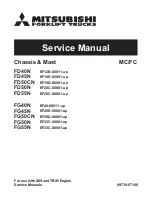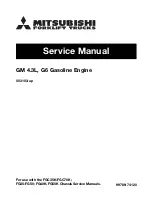
A 1
0505
.USA
A Following the rules- common sense and
the law
In 1998, OSHA reported on its thorough study of industrial truck use. This report may
be found at
Federal Register
/ Vol. 63, No. 230. In its report, OSHA explained its
many reasons for carefully defining the duties of employers to train their employees
in the use of industrial trucks, and the duty of untrained persons not to operate indus-
trial trucks except in controlled, training circumstances. The report addresses how
critically
important the training required by the OSHA regulations is for the safety of
people and things wherever industrial trucks are operated. 29 CFR sec. 1910.178. In
simple terms, careful training before operation of an industrial truck is
critical
and
must
occur before truck operation because accidents resulting in injury, death or
property damage almost always result from disregard of the basic risks inherent in
truck use or disregard of safety rules and procedures created to reduce or eliminate
those risks. The training required by OSHA is designed to address those risks. The
evidence provided by OSHA in its report reveals that the law’s operator training re-
quirements for employers and operators are grounded in experience and goog judg-
ment.
Jungheinrich has provided an industrial truck which complies with 29 CFR 1910.178,
and ASME B56.1. Jungheinrich representatives are available to assist and answer
any questions which may arise concerning the capacities, operation, use and main-
tenance of the truck.
According to OSHA, people do not start out with the knowledge and skills they need
to safely operate a powered industrial truck, and therefore, they need formal training
and practice to gain the knowledge and to master the skills they need to safely oper-
ate an industrial truck. Consequently, having an industrial truck which complies with
the law and standards fulfills only one half of the safety equation. It is, therefore, up
to you, the operator, and your employer, to fulfill your responsibilities by obeying all
national, state and local laws and regulations concerning training and the safe oper-
ation of industrial trucks - not just because it is the law, but because it also makes
common safety sense.
Only trained and certified persons may operate an industrial truck.
Training programs must comply with OSHA requirements and address, at least,
all of the topics listed there.
The user portion of ASME B56.1 is recommended to employers and operators
for careful review and observance.
“Safe operation is the responsibility of the operator“ ASME B56.1-2003, Part II
sec. 5.1.1.
A 1
0505
.USA
A Following the rules- common sense and
the law
In 1998, OSHA reported on its thorough study of industrial truck use. This report may
be found at
Federal Register
/ Vol. 63, No. 230. In its report, OSHA explained its
many reasons for carefully defining the duties of employers to train their employees
in the use of industrial trucks, and the duty of untrained persons not to operate indus-
trial trucks except in controlled, training circumstances. The report addresses how
critically
important the training required by the OSHA regulations is for the safety of
people and things wherever industrial trucks are operated. 29 CFR sec. 1910.178. In
simple terms, careful training before operation of an industrial truck is
critical
and
must
occur before truck operation because accidents resulting in injury, death or
property damage almost always result from disregard of the basic risks inherent in
truck use or disregard of safety rules and procedures created to reduce or eliminate
those risks. The training required by OSHA is designed to address those risks. The
evidence provided by OSHA in its report reveals that the law’s operator training re-
quirements for employers and operators are grounded in experience and goog judg-
ment.
Jungheinrich has provided an industrial truck which complies with 29 CFR 1910.178,
and ASME B56.1. Jungheinrich representatives are available to assist and answer
any questions which may arise concerning the capacities, operation, use and main-
tenance of the truck.
According to OSHA, people do not start out with the knowledge and skills they need
to safely operate a powered industrial truck, and therefore, they need formal training
and practice to gain the knowledge and to master the skills they need to safely oper-
ate an industrial truck. Consequently, having an industrial truck which complies with
the law and standards fulfills only one half of the safety equation. It is, therefore, up
to you, the operator, and your employer, to fulfill your responsibilities by obeying all
national, state and local laws and regulations concerning training and the safe oper-
ation of industrial trucks - not just because it is the law, but because it also makes
common safety sense.
Only trained and certified persons may operate an industrial truck.
Training programs must comply with OSHA requirements and address, at least,
all of the topics listed there.
The user portion of ASME B56.1 is recommended to employers and operators
for careful review and observance.
“Safe operation is the responsibility of the operator“ ASME B56.1-2003, Part II
sec. 5.1.1.
Содержание EKS 314
Страница 1: ...Operating manual 52032020 EKS 314 05 05 07 08 Manual de instrucciones u E...
Страница 9: ...0505 USA A 2 0505 USA A 2...
Страница 11: ...0505 USA B 2 0505 USA B 2...
Страница 17: ...0108 USA C 6 0108 USA C 6...
Страница 109: ...0505 USA H 8 0505 USA H 8...
Страница 117: ...0505 E A 2 0505 E A 2...
Страница 125: ...0108 E C 6 0108 E C 6...
Страница 187: ...1005 E E 50 1005 E E 50...
Страница 217: ...0708 E G 24 0708 E G 24...
Страница 225: ...0505 E H 8 0505 E H 8...

































